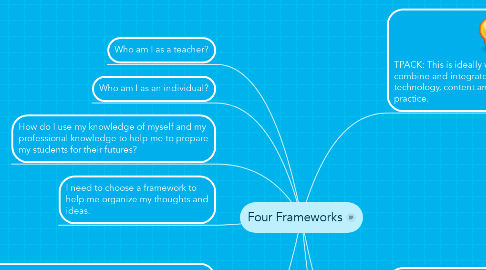
1. Who am I as a teacher?
2. Who am I as an individual?
3. How do I use my knowledge of myself and my professional knowledge to help me to prepare my students for their futures?
4. I need to choose a framework to help me organize my thoughts and ideas.
5. Philosophy of Teachnology
5.1. A Philosophy of Teachnology, in my mind, refers to combining your personal teaching philosophy with your ideas about technology. This would include thoughts on how technology can best be integrated in your classroom so that you and your students reach your maximum potential as learners in an increasing global society.
6. SAMR-The Substitution Augmentation Modification Redefinition Model: This model looks at how effective your integration of technology is in your classroom. It moves from simply enhancing the activities that you present, to transforming them. By transforming, I mean not only technology wise, but also by increasing the level of student engagement and the level of critical thinking and creativity students employ.
6.1. Enhancement
6.1.1. Substitution-when the use of technology is basically performing the same function as the original task dictated before computers were used in the classroom (like printing a worksheet from a website and having the students complete it with pencil).
6.1.2. Augmentation-when you use technology with slightly more impact than substitution. In other words, students are interacting more with the technology. For example, they could be completing a task completely online (like a test).
6.2. Transformation
6.2.1. Modification-Students make use of technology to complete tasks on a regular basis. Technology use is beginning to transform classroom practice. For instance, they could be completing a powerpoint presentation as a group to present at an assembly. This would require providing feedback to each other and their teacher, even when not at school (maybe through a public google doc they can all share and edit from home). They could add special effects to their powerpoint including music. Ideas and questions about the project implementation and contents are being generated more by the students and less by the teacher.
6.2.2. Redefinition-Here students are assigned tasks or complete work in such a way that it would not have been possible or even plausible before the use of technology. For instance, students could research another culture by exploring the regions' topography at ground level using google maps, chat live with students from that region using Skype, and compile everything they've learned by creating a documentary. In this way, technology is a support to the learning taking place. The questions that arise from completing a task such as this become much more student than teacher driven.
7. TPACK: This is ideally what you have when you combine and integrate your knowledge of technology, content and pedagogy in your daily practice.
7.1. When you combine knowledge of pedagogy with knowledge of technology, you end up with technological pedagogical knowledge (TPK).
7.1.1. TPK
7.1.1.1. Pedagogical Knowledge: Pedagogy describes my knowledge of how to go about teaching. It includes things like: my understanding of child development, how to manage a classroom, developing units and lessons, and assessment.
7.1.1.2. Technological Knowledge: This is what I know about the technologies that I use to help me teach. It ranges all the way from rudimentary use of chalk, pen and paper, to software, hardware and the internet. It changes as new technologies emerge and I continue to learn about them.
7.2. When you combine content and technology knowledge, you end up with technological content knowledge (TCK).
7.2.1. TCK
7.2.1.1. Technological Knowledge: This is what I know about the technologies that I use to help me teach. It ranges all the way from rudimentary use of chalk, pen and paper, to software, hardware and the internet. It changes as new technologies emerge and I continue to learn about them.
7.2.1.2. Content Knowledge: This is the specific knowledge that I have that pertains to the subject matter that I am teadhing. Since I am an elementary teacher, I need to know the facts, concepts and theories that are applicable to all subject areas being taught in K-grade 6.
7.3. When you combine pedagogical knowledge and content knowledge you end up with pedagogical content knowledge (PCK).
7.3.1. PCK
7.3.1.1. Pedagogical Knowledge: Pedagogy describes my knowledge of how to go about teaching. It includes things like: my understanding of child development, how to manage a classroom, developing units and lessons, and assessment.
7.3.1.2. Content Knowledge: This is the specific knowledge that I have that pertains to the subject matter that I am teadhing. Since I am an elementary teacher, I need to know the facts, concepts and theories that are applicable to all subject areas being taught in K-grade 6.
